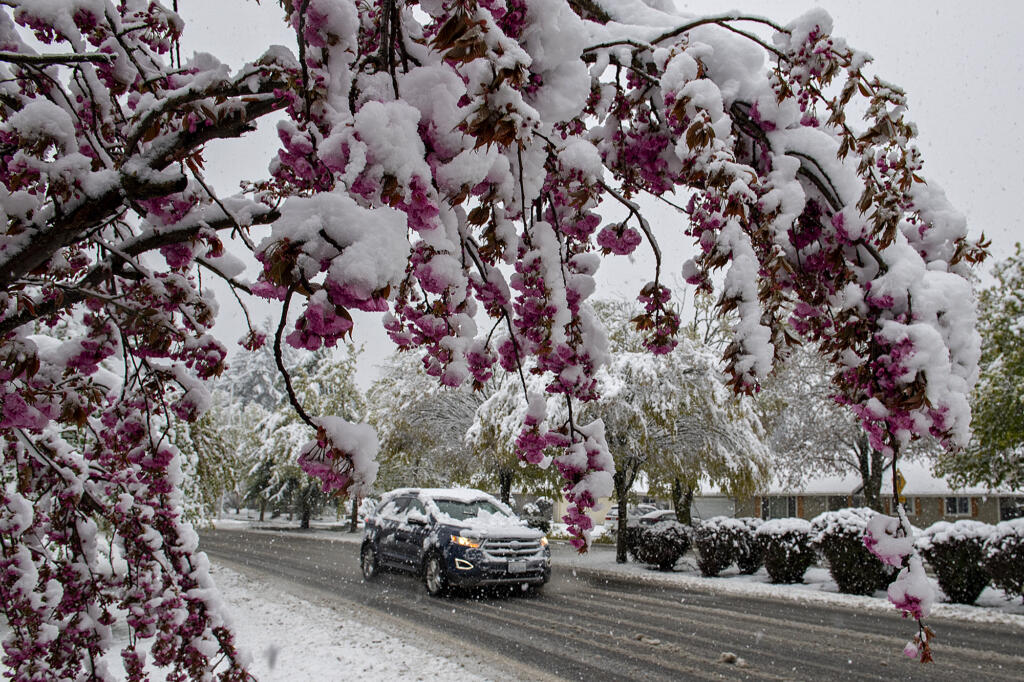SEATTLE —A series of powerful, cold April storms boosted the region’s snowpack, yielding plentiful powder for skiers and helping bolster water supplies for key irrigated agricultural areas east of the Cascades.
During the first 15 days of April, the statewide snowpack jumped from 80% of average to 96% of average. One site that measures snowfall near Snoqualmie Pass recorded 89 inches during that period, a record, according to Scott Pattee, of the Washington office of the Natural Resources Conservation Service.
But the chill weather that made this possible also has put many Washington farmers on edge as subfreezing temperatures this past week hit orchards, vineyards and fields.
“We are definitely concerned and nervous. We know there is damage out there but it is really difficult to assess the effect on the crops,” said Sean Gilbert, a fruit grower in the Yakima Valley of Central Washington.
The late-season bounty of snowfall and rain has not fallen equally around the region. Some portions of Idaho, eastern and southern Oregon and California are struggling with serious water shortages that will reduce irrigation flows to some farmers.
In Washington, some wheat-growing regions have yet to recover from long-term deficits of moisture. And, even with all the April storms, most mountain drainages across the state still remain below averages for April 15, as measured between 1991-2020. The biggest deficits were in the Lower Yakima, still at only 59% of average, and the Klickitat drainage at 77%.
Meanwhile, the Central Puget Sound drainage east of Seattle as of Friday was at 107% of the long-term average. The Cascades in northern Oregon also got snow dump after snow dump this past week, creating memorable conditions at Mt. Hood Meadows ski resort.
Washington’s snowpack in recent years often has melted earlier than the long-term norms, which can dry out soils and prime the summer fire season. That is forecast to happen more often in the decades ahead as climate change, driven by the combustion of fossil fuels, raises global temperatures.
This year, at the end of a warm March, the snowpack appeared dense and “fully ripe” with any warm rains to launch another rapid, early melt, according to Nick Bond, the state’s climatologist.
The cold wet April has helped delay the snow melt deeper into the spring. The later the snow melt, the more the runoff can help sustain summer river flows that generate electricity as they are run through hydropower turbines at dams, and are key migration corridors for salmon returning from the sea to spawn.
One striking aspect of the past week’s storms has been the low-elevation snow, which has fallen across a wide expanse of the state including key agricultural areas of Central and Eastern Washington.
Lon Inaba, general manager of Yakama Nation Farms, said several inches of heavy wet snow set back the asparagus crops but was an overall benefit because the 1,500 vegetable and fruit acres were dry and needed moisture.
“We really needed the water, so I will take a lost week of asparagus,” Inaba said.
Scott Revell, manager of the Roza Irrigation District, said a slight water shortage had appeared likely for the 2022 growing season. But he now expects there will be ample water for the 72,000 irrigated acres within the district. Much of that acreage is planted in high-value fruit orchards, and some have experienced temperatures in the low 20 degrees Fahrenheit.
To raise temperatures in the orchards, growers have used blowers that create wind, as well as warmer irrigation water.
“I have heard from a couple of growers who said that we are in uncharted territory,” Revell said.
At Gilbert Orchards, which gets some of its water from the Roza Irrigation District, the cold snap hit when apricots already had set small green fruit. Some of them now have bits of brown.
Cherry trees have been in full bloom and some apple varieties are beginning to flower, and all are vulnerable to damage.
During the next few days, as the weather finally warms, Gilbert said he will have a better grasp of the cold’s impact.



